
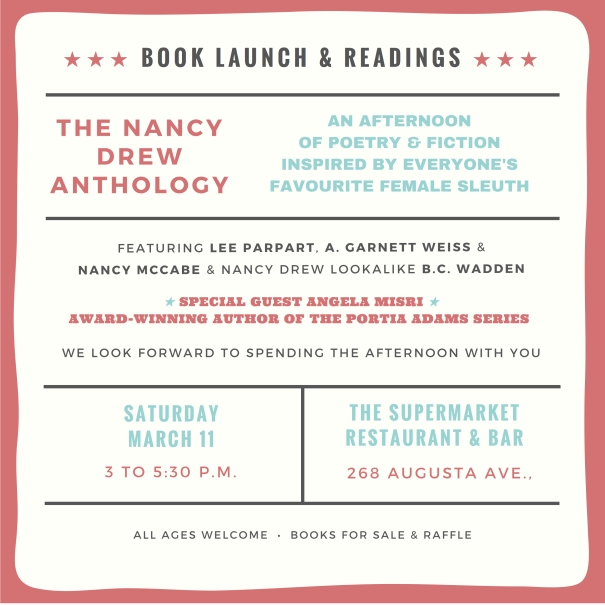

We are honored and pleased that Porter Square Books in Cambridge, Massachusetts, will host a reading for the Nancy Drew Anthology (Silver Birch Press, October 2016). East Coast authors featured in the 212-page collection of writing & art — Kathleen Aguero, Jessica Purdy, Ellen Cohen, Kristina England, and Sarah Nichols — will read their work included in the anthology. Details below.

WHERE: Porter Square Books, 25 White Street, Cambridge, Massachusetts, 02140, 617-491-2220, portersquarebooks.com.
WHEN: Friday, 2/24/17, at 7 p.m.
WHO: Kathleen Aguero, Jessica Purdy, Ellen Cohen, Kristina England, and Sarah Nichols will read selections from the Nancy Drew Anthology.
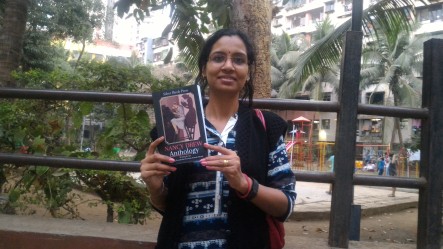
The 97 contributors to the Nancy Drew Anthology (Silver Birch Press, October 2016) are sending photos featuring the book in their home environments for a series we’re calling “Nancy Drew Around the World.” Author Vijaya Gowrisankar provided this photo taken ouside the Sanskruti Building in the Thakur Complex, Kandivili (East), Mumbai, India. Vijaya contributed the poem “Darkness now intrigues,” featured below, to the collection.
Glow of light a constant companion
For darkness was a frightening feeling
From streetlights to night lamps to stars
Or a torch that I always carried as armor
Or tightly clasped hands of elders as support
This defined me for the first ten years of life
Nancy Drew then crept in, to replace Enid Blyton books
Fingernails chewed as each page unraveled her strength
Sleepless nights where darkness was forgotten
As mind grappled with the plot of each mystery
Each book left me yearning for more, filled with awe
She became an inseparable part of my life and thoughts
An invisible friend, not an imaginary fictional character
She brought about subtle changes in my personality
My walk was more confident, fear fled to find another victim
I was more alert of my surroundings, no longer a shrinking violet
Looking at life and people with a different perspective
My parents smiled secretly at this transformation by Nancy Drew
ABOUT THE AUTHOR: Vijaya Gowrisankar released her third book of poems, Explore, in December 2016. Her first two published books Reflect and Inspire, are bestsellers. She was announced as one of the winners of Inspire by Gandhi competition, organized by Sampad, a UK organization. She has been announced as the Winner of AZsacra International Poetry Award (Dec. 2015). Her submissions have been published in Forwardian, Triadae Magazine, iWrite India, Dystenium Online, Taj Mahal Review, and Silver Birch Press. A participant in the Poetry Marathon 2016 (24 poems in 24 hours, 1 poem per hour), she has also reviewed and edited poetry and fiction books. She participated in NaNoWriMo 2016 and completed her first novel in November 2016.
Find the Nancy Drew Anthology at Amazon.com.
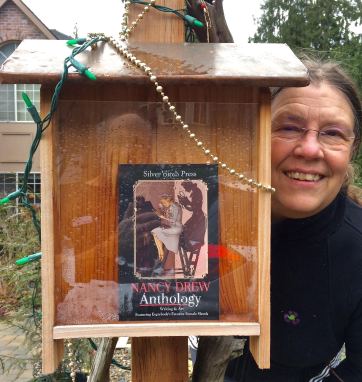
The 97 contributors to the Nancy Drew Anthology (Silver Birch Press, October 2016) are sending photos featuring the book in their home environments for a series we’re calling “Nancy Drew Around the World.” Author Tricia Knoll provided this photo taken at the poetry box outside her house in rainy Portland, Oregon, with the remnants of holiday decorations. Tricia contributed the poem “The Secret at Shadow Ranch,” featured below, to the collection.
Oh give me a home
where shadows share
mirror limbs and leanings
whisper, weighing
nothing, casting backwards.
In slipshod light, gallop me
somewhere new.
When shadows evaporate
at corners, play hide and seek.
When they beg to race,
saddle up. Stow your secret
watch, find the red-rock cave,
listen to the old woman’s wisdom.
Stretch me longer
than before.
Find the Nancy Drew Anthology at Amazon.com.
ABOUT THE AUTHOR: Tricia Knoll is an Oregon poet whose work appears in many journals and anthologies. Her chapbook Urban Wild focuses on human interactions with wildlife in urban habitat. Ocean’s Laughter (2016) combines lyric and eco-poetry to look at change over time in a small Oregon North Coast town. Her website is triciaknoll.com.
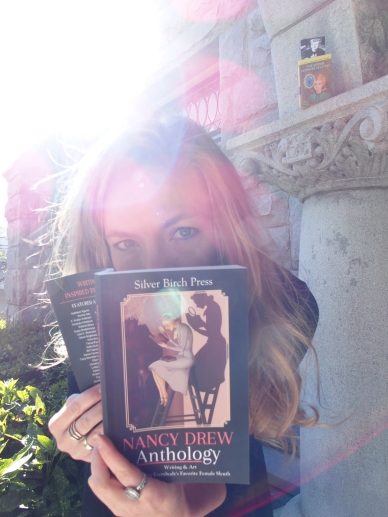
We asked the 97 contributors to the Nancy Drew Anthology (Silver Birch Press, October 2016) to send photos featuring the book in their home environments for a series we’re calling “Nancy Drew Around the World.” Author Julie E. Bloemeke provided these photos taken at Rhodes Hall in Atlanta, Georgia. Julie contributed the poem “Triple Hoax,” featured below, to the collection.
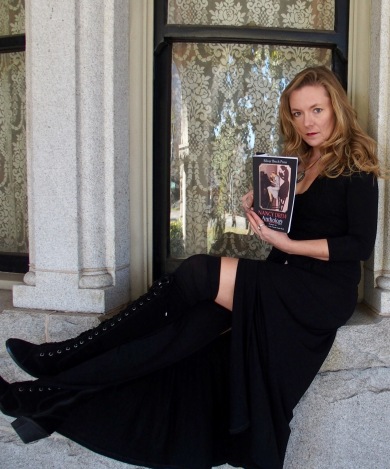
AUTHOR’S NOTES ON THE PHOTOS: I submitted two photos, a reflection of duality in my history with Nancy Drew. In both, I wear a pendant, bought years ago precisely because it reminded me of the spider sapphire on the cover of one of the hardback Nancy Drew books I owned and read as a girl. In the first shot, there is a portrait of Millie Benson, far more an adventurer and rogue spirit than my poem gives her credit for. It is my way of paying homage to my fellow Toledoan writer. A high wind raced over the porch as I took the photos. The only way to keep Millie in place was to tape her photo to the inside cover. The gusts were so strong that my copy of The Spider Sapphire Mystery blew off of the columns, many times, missing my head by mere inches.
I chose to shoot at Rhodes Hall in Atlanta for its columns and stone, its suggestion of castle, its name, Hall, another tip to other Nancy Drew titles and locations. The sun flare reminds me of ghosts, orbs, another layer of mystery, all caught without my knowing as these are self-portraits, taken with a timer. I could not see my pose or the light; it was all a mix of guesswork and chance. So when I went back and brought up the frame, lit as it was, with Mildred looking over Nancy, Nancy looking over me, me looking over the anthology, it seemed a haunting serendipity.
In the other photo, I wanted to unbutton Nancy, to satisfy some of her longing, and mine. Perhaps I wanted to scandalize Millie a bit too. I left many clues; the more one regards the photo, the more there seem to be. The old lace in the window is both a hint to a Nancy Drew title, and to one of the only humorous lines of poetry I have — as of yet — written. My boots are also a metaphor: all of the suggestive seduction of tying and untying, brass bound, the hidden staircase of want. The ring I wear was made in Toledo; I purchased it from the Toledo Museum of Art after my poem won the 2015 ekphrastic contest there. Look closely at the layers in the window; there are two people passing by, made captive by the camera, caught and reflected back, people I did not see at the time. With no one behind the lens, my expressions are for an unknown, the intensity behind my eyes a surprise even to me.
How I searched those promising titles,
their suggestive seductions: scarlet
slippers, brass-bound trunks, hollow
oaks that refused to reveal where.
How every mystery stopped me,
Ned and Nancy at another “No
Trespassing” sign, perfect set-up
of near lust again interrupted.
How could Ned and Nancy resist
all those heavy breathing phone calls,
that sensual slinking behind
moss-covered mansions, intense
whispers in the dim light of twisted
candles, the two of them, alone, crouched
under the hidden window, fingering
that spider sapphire in the dark?
Book after book, I began to get a clue,
suspect a double jinx, but still I held out,
determined to find the key
to Nancy’s jewel box, the secret
of Shady Glen, hoping that Nancy
would rip off her velvet mask, slip
under the hidden staircase, unbutton
that old lace and say, here, Ned,
is the real twin dilemma.
But instead, there was only the persistent
mystery, the tease of the broken
locket, those damned leaning chimneys,
the crossword cipher that kept me—
captive witness, dancing puppet—
from unveiling the silent suspect,
the true sinister omen, the phantom
trick behind the text,
the Carolyn Keene who wasn’t
so Carolyn
or Keene,
who wrote Ned and Nancy
into perpetual chaste,
the hex of a wooden lady
who never held a secret after all.
Clue: 23 Nancy Drew titles below. *
* (1) The Triple Hoax (2) The Scarlet Slipper Mystery (3) The Mystery of the Brass-Bound Trunk (4) The Message in the Hollow Oak (5) The Mystery at the Moss-Covered Mansion (6) The Sign of the Twisted Candles (7) The Hidden Window Mystery (8) The Spider Sapphire Mystery (9) The Double Jinx Mystery (10) The Clue in the Jewel Box (11) The Secret of Shady Glen (12) The Clue of the Velvet Mask (13) The Hidden Staircase (14) The Secret in the Old Lace (15) The Twin Dilemma (16) The Clue of the Broken Locket (17) The Clue of the Leaning Chimney (18) The Clue in the Crossword Cipher (19) Captive Witness (20) The Clue of the Dancing Puppet (21) The Silent Suspect (22) The Sinister Omen (23) The Secret of the Wooden Lady
NOTE FROM THE AUTHOR: A sleuth of intuition, Nancy searched for symbols, signs, clues, not only to solve cases, but the mysteries of the people she encountered — their gestures, tone of voice, shifty glances, contradictory stories. And Ned, her “special friend,” was curiously exempt. Ned and Nancy snuck out, broke rules, trespassed, untied each other, freed one another from kidnappers and enemies. He rescued her; she rescued him. And yet in all of this, no passion or true physical intimacy, not even a startling kiss to emphasize the throes of their continual life-or-death predicaments. I read Nancy Drew voraciously, waiting for such a moment, hoping the detective I so admired for her pluck would let her guard down, expose the clues of desire. And when she didn’t, I began to feel a sense of betrayal and frustration, a flagging trust, as if the hex had been on me all along. Couple this with my discovery that Carolyn Keene — who I much admired and longed to be — was not a person but a pseudonym, and I felt doubly duped. It was only in further research for “Triple Hoax” [included above] that I learned another truth. Growing up in Toledo, Ohio, I spent almost two decades living only miles from Mildred Wirt Benson — largely Carolyn Keene — while she was alive, and often still writing. It is a great regret that I only discovered this well after her death.
ABOUT THE AUTHOR: Julie E. Bloemeke’s poetry manuscript, Slide to Unlock, was recently chosen by Stephen Dunn as a 2016 finalist for the May Swenson Poetry Award. Her manuscript also placed as a semifinalist in six book prizes, among them the 2016 Crab Orchard Review Poetry Open Competition, the 2016 Washington Prize, the 2015 Hudson Prize, and the 2015 Crab Orchard Poetry Series First Book Award. A graduate of the Bennington Writing Seminars and a 2016 fellow at the Virginia Center for the Creative Arts, her work has appeared or will be published in Gulf Coast, Crab Orchard Review, Chautauqua Literary Journal, Drunken Boat, Poet Lore, The James Dickey Review, Four Chambers, and Bridge Eight among others. Her work has also been included in various anthologies, including The Southern Poetry Anthology Volume V: Georgia, My Cruel Invention, and The Great Gatsby Anthology, among others. A 2016 finalist for the Saluda River Poetry Prize for the state of South Carolina, she was also the winner of the 2015 ekphrastic competition at the Toledo Museum of Art, where her work was on view with the Claude Monet collection. In November she served as the inaugural Poetry Director for the Milton Literary Festival in Georgia.
Find the Nancy Drew Anthology at Amazon.com.
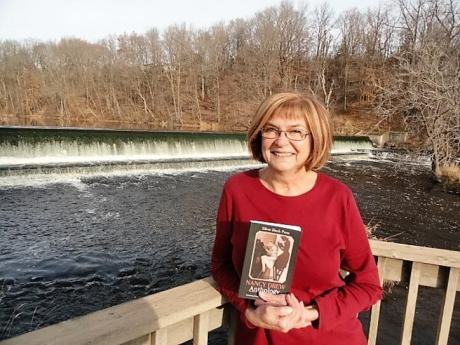
We asked the 97 contributors to the Nancy Drew Anthology (Silver Birch Press, October 2016) to send photos featuring the book in their home environments for a series we’re calling “Nancy Drew Around the World.” Author Marilyn Zelke-Windau provided this photo taken at Sheboygan Falls, Wisconsin. Marilyn contributed the poem “Long Overdue,” featured below, to the collection.
I’m reading Frank Dixon now.
It’s a Hardy Boys Mystery.
I found it amongst your death’s leavings.
The first page is mildewed.
It says, “After 30 days, return to Dave.”
At bedtime, when I was eight,
I read Nancy’s stories
of the moss-covered mansion
and the broken locket
and the old clock, attic, stagecoach.
I was in love with Ned Nickerson.
You were curled up in your own room,
on the daybed, with your heroes.
Night pulled shades down at 9 o’clock
but parental rules mustered youthful ploys.
A flashlight beamed bright my sheet shelter.
In your room a nightlight was the factor at play.
Batteried lights didn’t burn holes in blankets.
They only woke us kids at 3.
Then, after droop-eyed bathroom calls,
our legs shifted mystery dog-eared pages
to bed bottom,
where reading would be resumed,
tented,
tomorrow.
NOTE FROM THE AUTHOR: Nancy Drew books were a mainstay of comfort for me as a young girl. I learned from her that it was okay to be a smart girl, to like puzzles, to try to figure out solutions—sometimes creative solutions—and to stick to a problem until an answer could be found. I cherished that alone time with Nancy, reading in bed, under the dining room table, or in the waterless bathtub with blankets and a pillow, door locked so that no one would interrupt me. Most of the books I checked out from the library. They had old bindings. I didn’t know then that there were several people who wrote under the pen name Carolyn Keene. Soon, Nancy’s mysteries were coming out more and more quickly. My allowance money was always gone at the bookstore. My birthday and Christmas lists became full of titles. I still have most of these books here at home. They stare at me and implore me to remember and reread them.
ABOUT THE AUTHOR: Marilyn Zelke-Windau is a Wisconsin poet and a former elementary school art teacher. She enjoys painting with words. Her poems have appeared in many printed and online venues including Verse Wisconsin, Stoneboat, Your Daily Poem, Midwest Prairie Review, and several anthologies. Her chapbook Adventures in Paradise (Finishing Line Press) and a full-length manuscript, Momentary Ordinary (Pebblebrook Press), were both published in 2014. She adds her maiden name when she writes to honor her father, who was also a writer.
Find the Nancy Drew Anthology at Amazon.com.
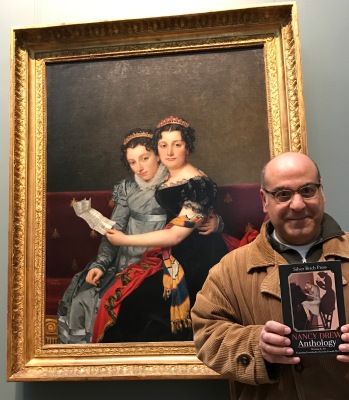
We asked the 97 contributors to the Nancy Drew Anthology (Silver Birch Press, October 2016) to send photos featuring the book in their home environments for a series we’re calling “Nancy Drew Around the World.” Author Shahé Mankerian provided this photo taken at The Getty Center in Los Angeles. Shahé contributed the poem “Dear 12-Year-Old Self,” featured below, to the 212-page anthology.
Ride your bicycle a lot.
Don’t pick up magazines
in the alley. Don’t call
any of the girls. Samantha
does not exist. Her phone
number belongs to Tyrone.
If you want to talk
to girls, go to the library.
The girl sitting pretzel style
in the Nancy Drew aisle
might be shy, but talk to her.
She will know more
about boys than Samantha
or Tyrone. Carry the books
she checked out to her bike.
Memorize the titles
because your job is to know
Nancy Drew. After you watch
her ride off into the sunset,
run to the checkout desk,
and apply for a library card.
NOTE FROM THE AUTHOR: While visiting the Getty Center in Los Angeles, I couldn’t help notice the painting by the French painter Jacques-Louis David. In the portrait, the Sisters Zénaïde and Charlotte Bonaparte (Napoléon Bonaparte’s nieces) stare at the viewer blankly as if they are caught reading a secret letter. A clue. Naturally, the painting reminded me of Nancy Drew. More so, it reminded me of the Anthology cover: Nancy Drew’s shadow keeps her company as she sits hunched over a clue. The shadow acts as an extension, Nancy’s body double. Finally, look at Nancy’s stylish gray dress suit, and the depiction of the overextended shadow in obvious black. Now, look at the painting. Notice the colors of the clothing on the Bonaparte sisters? Gray and black. Coincidence?
ABOUT THE AUTHOR: Shahé Mankerian is the principal of St. Gregory Alfred and Marguerite Hovsepian School in Pasadena, California, and the co-director of the Los Angeles Writing Project. As an educator, he has been honored with the Los Angeles Music Center’s BRAVO Award, which recognizes teachers for innovation and excellence in arts education. His most recent manuscript, History of Forgetfulness, has been a finalist at four prestigious competitions: the 2013 Crab Orchard Series in Poetry Open Competition, the 2013 Bibby First Book Competition, the Quercus Review Press, Fall Poetry Book Award, 2013, and the 2014 White Pine Press Poetry Prize. His poems have been published in numerous literary magazines.
Find the Nancy Drew Anthology at Amazon.com.
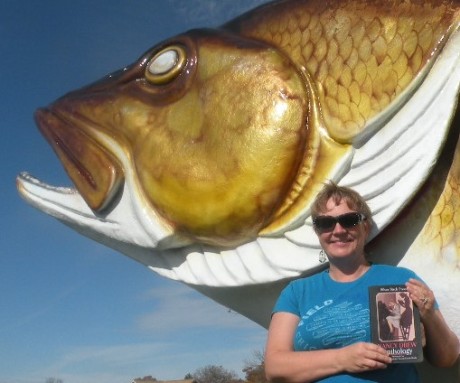
We asked the 97 contributors to the Nancy Drew Anthology (Silver Birch Press, October 2016) to send photos featuring the book in their home environments for a series we’re calling “Nancy Drew Around the World.” Author Jennifer Hernandez sent this photo of herself and the book in front of the giant walleye at Lake Mille Lacs on a road trip home from the League of Minnesota Poets fall conference. As she tells us, it doesn’t get a whole lot more Minnesotan than this! Jennifer contributed the poem, “Nancy Drew is my kind of princess,” featured below, to the collection.
flashlight scepter in hand
Sleuthing through secret passages,
tunnels, attics, caves
Girl detective slays her own dragons
needs no rescue
Sheathed in smart frocks with
matching handbags
Strawberry blonde hair
tucked behind one ear
Clues deduced
mysteries solved
Blue roadster
speeding into the sunset
ABOUT THE AUTHOR: Jennifer Hernandez teaches and writes in the Minneapolis area. Her work has appeared recently in Mothers Always Write, Rose Red Review, Silver Birch Press, and anthologized in Bird Float, Tree Song (Silverton Books). She has performed her poetry at a nonprofit garage, a bike shop filled with taxidermy, and in the kitchen for her children, who are probably her toughest audience.
Find the Nancy Drew Anthology at Amazon.com.
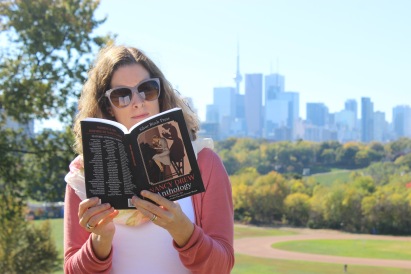
We asked the 97 contributors to the Nancy Drew Anthology (Silver Birch Press, October 2016) to send photos featuring the book in their home environments for a series we’re calling “Nancy Drew Around the World.” Author Lee Parpart provided this photo taken at Riverdale Park in Toronto, Ontario, Canada, with the CN Tower and the downtown Toronto skyline in the background. Lee contributed the prose piece “Nancy drew,” featured below, to the 212-page anthology.
Whenever things got slow around River Heights, or when there were personnel changes over at the Stratemeyer Syndicate that upset her or made her feel less invested in her own development as a character, Nancy coped by drawing.
Her most fertile period as an artist came in the gap between books 7 and 11. Mildred A. Wirt, aka the first Carolyn Keene, was on strike to protest the lowering of freelance rates at the syndicate during the Depression, and had been replaced by a male journalist, who wrote books 8, 9, and 10.
To distract herself from the loss of her preferred author, Nancy drew. In the couple of years that passed between The Clue in the Diary and The Clue of the Broken Locket, she completed at least a dozen self-portraits, crowding most of them onto a single large sheet of paper left behind by one of the Stratemeyer illustrators. For each drawing or set of drawings, she used a different method to capture some aspect of her appearance or some element of her character that she suspected might have been missed.
The first two sessions took the form of a mystic, Dada-style experiment in automatic writing, with Nancy wearing a blindfold and giving herself exactly one minute per portrait. Instead of drawing her own features, she sketched a rough outline of her body, then attempted, without being able to look at the lines, to fill the image with written notes.
The first one made her look like a polar bear and overflowed with adjectives handed down by various members of the team responsible for her creation: Peppy, Plucky, Curious, Kind.
The other attempt, which came out looking more like a real female silhouette, contained words and phrases not heard around the office, but whose meanings resonated with her as possible clues to her overpowering, lifelong need to identify and solve mysteries. Unflinching. Dogged. Determined. And a more shadowy phrase that was just coming into parlance in America at the time: anti-authoritarian.
In a bad experiment never to be repeated, Nancy drew one portrait of herself while driving her blue roadster through the center of River Heights. This was deeply out of character and almost had dire consequences when Nancy hopped a curb near the soda shop and came close to hitting a young couple in mid-kiss.
An equally frivolous, though much less risky, formal approach involved using vegetable-based watercolors to create a simple portrait of herself driving the roadster, then using treats to encourage Togo to lick the image until it took on a loose, indistinct quality that made her think of beaches and Toulouse-Lautrec.
In homage to both M.C. Escher and her main creator, Nancy once depicted herself as half a silhouette in the process of being drawn by the curved hand of Mildred Wirt. Nancy knew Mildred was a writer, not an artist, but she wanted to be sure to give the almost forgotten original author due credit for her own existence.
In one final drawing carried out shortly before Mildred was reinstated, Nancy used a magnifying glass to closely inspect the skin of her forearm, and devoted herself to reproducing exactly what she saw there. Good detecting was about learning how to look, and she wanted to test her skills at observation with an abstract visual puzzle. She focused intently on this task for several days, finally producing an intricately detailed, almost trompe-l’oeil, rendering of a one-inch patch of skin that included a network of criss-crossing lines not visible to the naked eye, punctuated by a small brown birthmark that she had known was there, but never bothered to explore. At the end of this intense period of struggle and reflection, she felt she knew herself better than at any other point in her story.
Nancy drew until she became tired of drawing. Mildred Wirt returned to the publishing house later that week, almost as though she was summoned back by the creative energies of her own creation. With Stratemeyer’s personnel problems solved, Nancy sat down next to her author and began to think about writing.
NOTE FROM THE AUTHOR: “Nancy drew” isn’t exactly a short story. It’s closer to a piece of conceptual fiction, supported by elements of nonfiction. As some devoted fans of the Nancy Drew series will probably recognize, the references to the Stratemeyer Syndicate and Mildred Wirt’s job action in the early 1930s are based in fact.
ABOUT THE AUTHOR: Lee Parpart worked as an arts journalist and a media studies researcher before returning to her earliest passion, creative writing, in 2015. Her essays on Canadian, US, and Irish cinema have appeared in books and journals, and she has served as a film and visual arts columnist for two major dailies. Her poetry has appeared in numerous Silver Birch Press series, and she was named an Emerging Writer for East York in Open Book: Ontario’s 2016 What’s Your Story? competition, which highlighted the work of writers in four neighbourhoods across Toronto. Her short story, “Piano-Player’s Reach,” appeared in an anthology published by the Ontario Book Publishers Organization. To find out more about Lee’s work, please visit her website.
Find the Nancy Drew Anthology at Amazon.com.
Author photo by Ron Wadden.
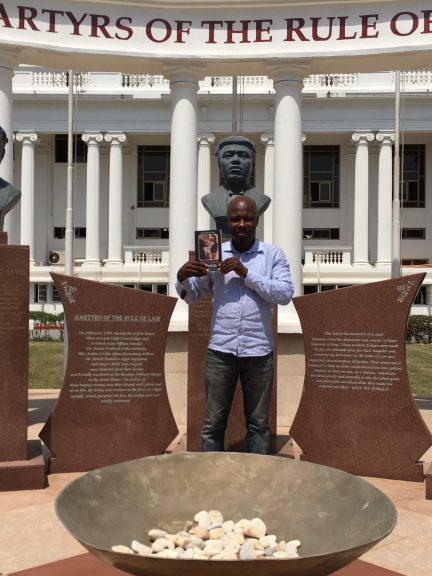
We asked the 97 contributors to the Nancy Drew Anthology (Silver Birch Press, October 2016) to send photos featuring the book in their home environments. Author Geosi Gyasi provided this photo of himself and the book in front of the Parliament of Ghana (The Republic of Ghana, West Africa). Geosi contributed the prose poem “Speech & Prize-Giving Day,” featured below, to the 212-page anthology.
After the speech & prize-giving day, I opened the prize. Winning the first prize in math was no mean feat. You would understand why. The numbers speak for themselves. Out of two hundred students in class, I was the top. But I was weak in other subjects too. Particularly, English, where the teacher bothered us with tons and tons of classics. Shakespeare, Chaucer, Tolstoy, you name them. I opened the prize to find a surprise. A storybook. That was the prize. Nothing more. Nothing less. What was a top student in math going to do with a Nancy Drew book? I gave the book a befitting burial. Inside my box, I hid it in a cloud of darkness. Never to see it again until the time of resurrection. When I met Nancy at page one, she held my arms through a journey. With unexpected twists and turns. I was afraid like Ellen Smith who was offered a job to teach piano lessons. At the mysterious place of Rocky Edge. I held my breath at page eight. When Nancy entered the abandoned one-room cottage. The map and the buried treasure quickly came to mind. I was scared for Nancy’s life. Eager to know what would happen next.
ABOUT THE AUTHOR: Geosi Gyasi is a book blogger, poet, and interviewer. His work has appeared or is forthcoming in Galway Review, Grey Sparrow Journal, Indiana Voice Journal, Silver Birch Press, and Juked. He is the author of the forthcoming book Geosi Interviews Fifty Writers Worldwide (2016) from Lamar University Literary Press in Texas (U.S.). The winner of the 2015 Ake/Air France Prize for Prose, he blogs at geosireads.wordpress.com.
Find the Nancy Drew Anthology at Amazon.com.

